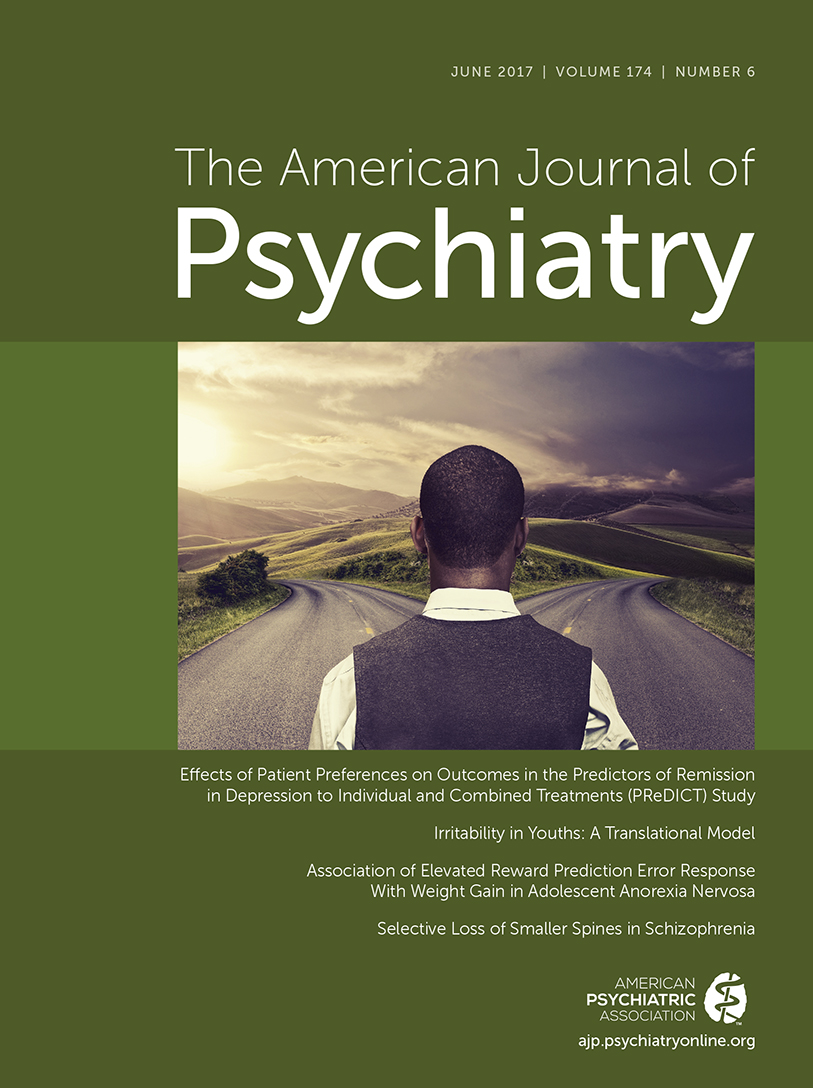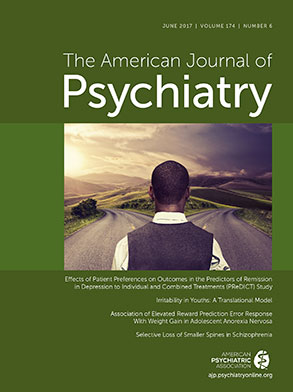In this issue of the
Journal, Dunlop et al. (
1) conducted a definitive, 12-week randomized controlled trial with moderately symptomatic, treatment-naive, depressed outpatients that compared well-delivered cognitive-behavioral therapy (CBT), escitalopram, and duloxetine with rater-blinded 17-item Hamilton Depression Rating Scale scores.
These “treatment-naive” study patients, recruited largely by advertising, were substantially burdened by illness. About 50% had recurrent major depressive disorder; 30% were in a chronic major depressive episode (greater than 2 years); 7% had previously attempted suicide; and nearly half were unemployed. On average, 10 years had lapsed between the onset of the first major depressive episode and study entry. These features may reflect lack of access (although 50% had insurance), lack of awareness, or fear of treatment or stigmatization by entering treatment.
Overall, remission (48%), response (60%), and retention (60%–75%) rates were comparable across the three treatments. The onset of benefit seemed to be a bit slower with CBT than with medications, analogous to other reports (
2).
Treatment assignment was randomized, but patients expressed their preferences (if any) for medication or psychotherapy before randomization. One-third had no preference, and one-third preferred CBT or medication, respectively. Importantly, minority patients preferred CBT over antidepressant medication (81% for Hispanics; 46% for African Americans). Whether these preferences were due to distrust of medication, those prescribing it, or the desire to talk through problems, was not evaluated.
Retention rates, but not remission rates, were related to whether or not the treatment received was matched to patients’ preferences. Whether the type of mismatch affects remission rates is unclear. Those who preferred medication but received CBT (due to the randomization) had only a 33% remission rate; 45% of those who preferred CBT but received medication reached remission. This numerical difference was not statistically significant, possibly due to small samples.
Retention rates were higher (82%) for those whose treatment assignment matched their preferences compared with those who were mismatched (68%). This difference (driven by those with moderate to strong preferences) yielded a clinically meaningful number needed to treat of 7, which approximates the magnitude of drug-placebo differences reported in randomized controlled trials conducted for regulatory purposes. These findings argue for the importance of expectations and attitudes, which in turn affect engagement and retention in treatment. Had patients’ preferences first been solicited and then had treatments been assigned to match (or not match) these preferences, results might differ from this observational study.
Why would retention but not remission be affected by treatment match/mismatch? Sample sizes might have been too small to detect a differential effect on remission rates. Alternatively, perhaps depressed patients seeking treatment will accept whatever is available, but once less depressed and not matched to their preferred treatment, their motivation to continue on may simply wane.
These results have implications for care systems, patients, and clinicians. One important implication, especially for depressed, minority public sector patients, is that providing greater access to time-limited depression-targeted therapies might improve patient engagement and retention, as opposed to the nearly universal reliance on a “medication first” approach that may increase the risk of attrition in at least some.
Secondly, systems that care for a defined patient population would logically want to reduce attrition from treatment because many depressed patients who drop out, especially those with a chronic or recurrent history, will likely continue to use medical and mental health resources. In the Predictors of Remission in Depression to Individual and Combined Treatments (PReDICT) study, patients who dropped out had more severe symptoms of depression and anxiety and more concurrent anxiety disorders at pretreatment, all of which portend a poorer prognosis.
Another concern is that the overall outcomes in this acute treatment study are far from what we desire, even in these “treatment-naive” patients. If we regarded patients who completed the 12 weeks of treatment and achieved remission as full successes, then 344 eligible/randomized patients resulted in 234 patients who completed treatment, of whom 109 achieved remission. The 32% success rate (109/344) is comparable to the first treatment step in the Sequenced Treatment Alternatives to Relieve Depression (STAR*D) study (
3), which certainly leaves substantial room for improvement.
The substantial treatment dropout rates of depressed patients in PReDICT, STAR*D (
4), and other studies (
5) should remind us that mentally and emotionally accepting a diagnosis of depression, as well as understanding and committing to its treatment (whether medication or therapy), is far from trivial. Most depressed patients are not eager for antidepressant medication (
6). Furthermore, many will do as well with time-limited therapy (
7). Even when matched to their preference, 1 in 5 patients dropped out of the PReDICT study.
Both psychotherapy and pharmacotherapy require substantial commitment from patients, as well as a thorough understanding of what they need to do to make the treatments work safely and effectively. Both acute and continuation phases are recommended for medication, which could entail 7 months or more. On the other hand, some patients even with recurrent depression seem not to relapse after only a few months of acute-phase medication treatment (
8) Similarly, many depressed patients will do well with only acute-phase CBT, though evidence suggests better outcomes with more prolonged (continuation phase) treatments in at least some patients (
9).
What can we do to better engage and retain the roughly 1 in 3–4 depressed patients who leave treatment prematurely? We know that patients’ beliefs about the
necessity for and their
concerns about taking medication contribute substantially to medication adherence in general medical conditions (
10). Furthermore, attitudes and expectations about mental health and mental health treatments affect treatment preferences, engagement, and retention for psychotherapy (
11–
14) and for medications (
15,
16).
The typical several-minute discussion before recommending either medication or therapy is unlikely to affect attitudes, expectations, or preferences. Would it not be wiser and perhaps more cost effective to provide more extensive information and discussion to address patients’ specific questions about the necessity for and concerns about treatment options before beginning? Could this process reduce dropout? Or enhance adherence?
Could we not tailor and target information and promote shared decision making, especially with patients who are at greatest risk of premature attrition? Shared decision making might be especially appealing to younger patients who prefer an active role in treatment decisions (
17) and who are more likely to drop out prematurely (
18). Could such efforts perhaps be facilitated by cloud-based assistants from Amazon or Google? Of note, if shared decision making is to be taken seriously, we would be wise to make both therapy and medications readily available, which is not the case presently. This additional time and effort to better explain, and to collaborate and partner with patients and perhaps their support system, could have both short-term and even greater longer-term benefits, especially if the first treatment chosen is not fully successful.

